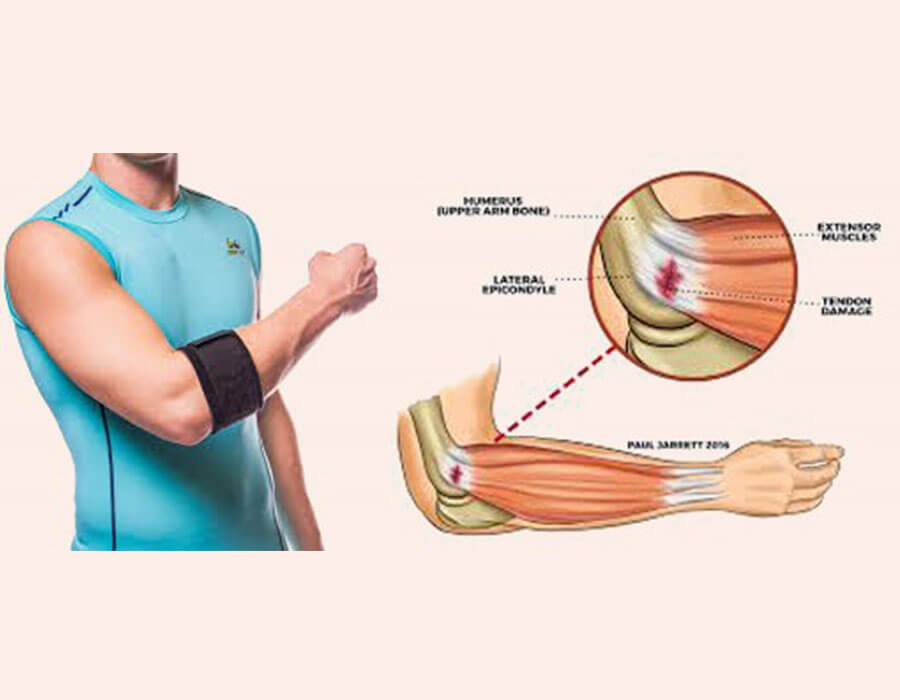Tennis Elbow

Tennis elbow (lateral epicondylitis) is a painful condition that occurs when tendons in your elbow are overloaded, usually by repetitive motions of the wrist and arm. Despite its name, athletes aren’t the only people who develop tennis elbow.The pain associated with tennis elbow may radiate from the outside of your elbow into your forearm and wrist. Pain and weakness may make it difficult to:
- Shake hands or grip an object
- Turn a doorknob
- Hold a coffee cup
- Open a box
How does tennis elbow develop?
Tennis elbow is an overuse and muscle strain injury. The cause is repeated contraction of the forearm muscles that you use to straighten and raise your hand and wrist. The repeated motions and stress to the tissue may result in a series of tiny tears in the tendons that attach the forearm muscles to the bony prominence at the outside of your elbow.
As the name suggests, playing tennis — especially repeated use of the backhand stroke with poor technique — is one possible cause of tennis elbow. However, many other common arm motions can cause tennis elbow, including:
- Using plumbing tools
- Painting
- Driving screws
- Cutting up cooking ingredients.
- Repetitive computer mouse use
Are there any special risk factors for developing Tennis elbow?
Factors that may increase your risk of tennis elbow include:
- While tennis elbow affects people of all ages, it’s most common in adults between the ages of 30 and 50.
- People who have jobs that involve repetitive motions of the wrist and arm are more likely to develop tennis elbow. Examples include plumbers, painters, carpenters, butchers and cooks.
- Certain sports.Participating in racket sports increases your risk of tennis elbow, especially if you employ poor stroke technique.
What are the treatment options available?
Tennis elbow often gets better on its own. But if over-the-counter pain medications and other self-care measures aren’t helping, your doctor may suggest physical therapy. Severe cases of tennis elbow may require surgery.
-
Therapy
If your symptoms are related to tennis, your doctor may suggest that experts evaluate your tennis technique or the movements involved with your job tasks to determine the best steps to reduce stress on your injured tissue.
A physiotherapist can teach you exercises to gradually stretch and strengthen your muscles, especially the muscles of your forearm. Eccentric exercises, which involve lowering your wrist very slowly after raising it, are particularly helpful. A forearm strap or brace may reduce stress on the injured tissue.
- Surgical or other procedures
- Dr Abhishek Haldar at OrthoVision Clinic suggests injecting platelet-rich plasma into the painful tendon. Dry needling — in which a needle pierces the damaged tendon in many places — can also be helpful.
- Ultrasonic tenotomy (TENEX procedure).In this procedure, under ultrasound guidance, the doctor inserts a special needle through your skin and into the damaged portion of the tendon. Ultrasonic energy vibrates the needle so swiftly that the damaged tissue liquefies and can be suctioned out.
- If your symptoms haven’t improved after six to 12 months of extensive non-operative treatment, you may be a candidate for surgery to remove damaged tissue. These types of procedures can be performed through a large incision or through several small incisions. Rehabilitation exercises are crucial to recovery.
Are there any self care measures that can be tried before undergoing surgery?
- Avoid activities that aggravate your elbow pain.
- Pain relievers. Try over-the-counter pain relievers, such as ibuprofen etc.
- Apply ice or a cold pack for 15 minutes three to four times a day.
- Make sure that you are using proper technique for your activities and avoiding repetitive wrist and arm motions.